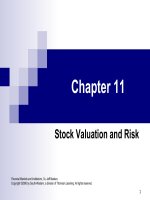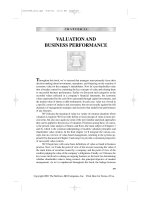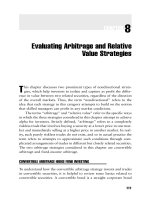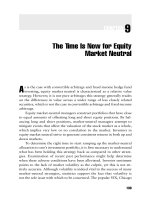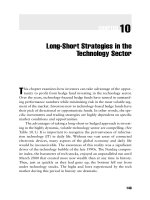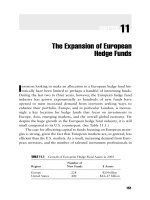Hedges on Hedge Funds Chapter 11 ppsx
Bạn đang xem bản rút gọn của tài liệu. Xem và tải ngay bản đầy đủ của tài liệu tại đây (161.2 KB, 15 trang )
CHAPTER
11
CHAPTER 11
The Expansion of European
Hedge Funds
I
nvestors looking to make an allocation to a European hedge fund his-
torically have been limited to perhaps a handful of interesting funds.
During the last two to three years, however, the European hedge fund
industry has grown exponentially as hundreds of new funds have
opened to meet increased demand from investors seeking ways to
enhance their portfolio. Europe, and in particular London, is increas-
ingly a key location for hedge funds that focus on investments in
Europe, Asia, emerging markets, and the overall global economy. Yet
despite the huge growth in the European hedge fund industry, it is still
small compared to its U.S. counterpart. (See Table 11.1.)
The case for allocating capital to funds focusing on European strate-
gies is strong, given the fact that European markets are, in general, less
efficient than the U.S. markets. As a result, increasing demand from Euro-
pean investors, and the number of talented investment professionals in
151
TABLE 11.1 Growth of European Hedge Fund Assets in 2003
Number of
Region New Funds $ Assets
Europe 228 $20 billion
United States 400 $24–27 billion
c11_hedges.qxd 8/26/04 3:01 PM Page 151
Europe, there is every reason to believe that the number of European
funds will increase. (See Figure 11.1.)
Investors should anticipate a robust but declining increase in the
rate of growth of European strategies in the next few years. Although
equity funds in Europe—both long/short and market neutral—remain
the biggest single group, they no longer account for a majority of the
152 HEDGES ON HEDGE FUNDS
GROWTH OF
EUROPEAN
HEDGE
FUNDS
As global equity markets
have faltered and
economic uncertainty
has increased, investors
increasingly realize that
hedge funds have their
place in an investment
portfolio.
INVESTOR DEMAND
One of the key
alternative asset classes,
venture capital, has
diminished in its
attractiveness to
investors through
reduced opportunities
and poor performance.
New legislation in a
number of European
countries has made
investing in hedge funds
more interesting from a
tax perspective.
REGULATORY
CHANGE
TRADING
OPPORTUNITIES
PRODUCT
OPPORTUNITY
European equity markets are not
as efficient as U.S. markets and
arguably offer good opportunities
for talented fundamental investors.
The Monetary Union has created
a more liquid capital pool as well
as increased the focus on the
need for restructuring in Europe,
thus creating unique opportunities.
FIGURE 11.1 The European Hedge Fund Landscape.
c11_hedges.qxd 8/26/04 3:01 PM Page 152
The Expansion of European Hedge Funds 153
assets. Arbitrage funds, convertible bond arbitrage; event-driven, statis-
tical arbitrage; and quantitative strategies, have grown more strongly
since 2000. Fixed-income and high-yield funds have increased most rap-
idly in terms of both number of funds and assets under management,
but they are still underrepresented compared to the United States. Global
macros also experiencing a turnaround, yet assets managed in the strat-
egy remain status quo. Funds focusing on distressed securities and equity
short sellers are few and far between.
There are a number of reasons for this growth.
■ As global equity markets have faltered and economic uncertainty
has increased, investors increasingly realize that hedge funds have
their place in an investment portfolio.
■ One of the key alternative asset classes, venture capital, has dimin-
ished in its attractiveness to investors, through reduced opportuni-
ties and poor performance.
■ Investors have increasingly recognized the compelling nature of the
opportunities in European markets; European equity markets are
not as efficient as U.S. markets and arguably offer good opportuni-
ties for talented fundamental investors. The Monetary Union, in
addition to creating a more liquid capital pool, also has increased
the focus on the need for restructuring in Europe. These factors
have increased interest in these markets from U.S. investors.
■ New legislation in a number of European countries has made invest-
ing in hedge funds more interesting from a tax perspective.
There has been much discussion of capacity constraints among
European hedge funds. The number of new funds starting up does not
address this concern, because many investors will be specifically seeking
funds with a reasonable track record. In a recent survey of pension
funds in Europe, one of the main reasons given for not investing in
hedge funds was the absence of long track records. It is true that many
of the funds with long and impressive track records are closed, if not
completely so, then at least to new investors. Some funds that are open
to existing investors only will not be able to accept limitless amounts.
c11_hedges.qxd 8/26/04 3:01 PM Page 153
154 HEDGES ON HEDGE FUNDS
And some funds with significant assets under management probably
should be closed, as they are at the point where further subscriptions
could have a negative impact on returns.
These facts may appear to confirm the concern that it is difficult to
get access to the best funds in Europe. However, closer inspection indi-
cates that many of these funds actually are selectively open. Those funds
that are in demand are increasingly eager to ensure a stable investor base,
particularly if they offer high levels of liquidity, and therefore they leave
the door open to “appropriate” investors who can demonstrate that they
understand the strategy and are investing on a longer-term view.
Furthermore, the idea that only a very limited number of good man-
agers exist in Europe is a misconception. Although some funds are con-
stantly turning away new money and others are struggling to raise even
$20 million, the levels of talent are not as unevenly distributed as these
extremes may suggest. Numerous funds have strong potential and may
even have developed a good track record, and they are very much open
to new investors.
As discussed, the nature of most hedge fund strategies is such that
there will be a limit to the level of assets under management. The poten-
tial pitfalls of having substantial assets under management have been
well documented. In the same way, when looking at European funds
specifically, it is necessary to look at the issues that might ensue from a
fund that has a relatively small level of assets under management.
Hedge funds in Europe manage from as little as $5 million in assets
up to $2.5 billion. The substantial number of new funds has meant that
there are an increasing number of hedge funds managing less than $50
million in client money. On one hand, this is a positive sign, as the funds
will be able to focus on the most attractive opportunities within the
strategy. This fact is particularly for strategies such as merger arbitrage,
in which currently very few appealing opportunities exist. Even where
there is a sufficient level of good investment opportunities, smaller funds
can be more flexible in approach; for example, they can take positions
in smaller capitalization stocks or deals.
However, a few important issues confront smaller funds. Smaller
funds may be at a disadvantage when it comes to contact with brokers
c11_hedges.qxd 8/26/04 3:01 PM Page 154
and with companies; the managers may lack sufficient pull to get one-
on-one meetings with company management. Investors need to bear in
mind that many hedge fund managers come from backgrounds that
have provided a broad and meaningful contact base and strong research
capabilities. In addition, hedge funds generate considerable commissions
for brokers. Their turnover levels are, on average, much higher than in a
traditional fund, and it is therefore in brokers’ best interests to provide
a good service to the smaller funds, so as not to lose out if and when the
fund grows in size.
Perhaps even more important, however, is the questionable opera-
tional viability of smaller funds. A number of funds, in some cases run
by very competent managers, have closed as the revenues from manage-
ment and performance fees on a relatively small asset base have not been
deemed sufficient to justify continuing. The best fund managers may not
be the best business managers, which funds can address by hiring some-
one to manage the business itself. Of course, this move means the com-
mitment of additional resources and in most cases means releasing some
equity or options over equity in the business, which in turn must be per-
ceived as being one with good growth potential. Sometimes this can be a
vicious circle. A number of larger allocators will be reluctant to invest in
small funds for the reasons just discussed and also because they will not
want to be holding too large a percentage of the fund. From our experi-
ence, funds tend to attract more attention from a wider range of inves-
tors when assets under management reach $50 million.
EuroHedge recently researched European hedge fund closures and
particularly the main reasons behind the closures and reported that 50 of
the 550 funds identified by EuroHedge as investing in European strate-
gies have closed over the last three years. For 35 of these 50 or so liq-
uidated funds, EuroHedge had full performance data. Of these funds,
65 percent had profitable performance, and investing in a portfolio of
these extinct funds actually would have produced positive returns.
These findings contradict the belief that investments in European funds
bring a significantly higher risk of failure through poor performance.
However, they do go some way to confirming our concern that a num-
ber of funds will close basically because they do not become profitable
The Expansion of European Hedge Funds 155
c11_hedges.qxd 8/26/04 3:01 PM Page 155
enough quickly enough. It should be pointed out, however, that there
have been more closures since the EuroHedge article, and some were
brought about by poor performance.
The size of funds can be very important in determining whether and
indeed when to make an investment, particularly “boutique” hedge
funds, as opposed to those managed from within a major institution. As
well as ensuring that the manager has a responsible approach to asset
growth, it is necessary to ensure that the manager’s business at least has
every chance of reaching “critical mass” in the near future and that it
will be operationally viable and able to commit to adequate resources
for the management of the investments and the business.
The European hedge fund industry is significantly less mature than
its U.S. counterpart, and the number of hedge funds that have been in
existence for more than, say, four years is small in comparison. Regard-
less of how impressive the manager’s record is, without a track record
of successfully managing a hedge fund, many investors will be reluctant
to commit capital to such a fund. This is understandable, given the addi-
tional skills that are required to run a successful hedge fund, not the least
of which is the ability to manage risk. In a recent example, a very suc-
cessful long-only manager in Europe set up a hedge fund. The confi-
dence in that manager was so high that large amounts of capital
followed, and the new fund reached capacity in a matter of months.
Such cases are, however, the exception rather than the rule.
An increasing number of firms are starting additional funds, par-
ticularly if their flagship fund is closed. If the main fund has an impres-
sive track record and the manager is well respected, the absence of a
track record for a new fund may not be considered an obstacle. But
such funds should be approached with caution. In some cases, the fund
may be a genuine extension of the manager’s core competencies and
the track record of the original fund can quite justifiably provide a his-
torical reference for the new fund. Yet such is not always the case.
Where there is an obvious diversion from the original investment strat-
egy, the fund should be treated as any start-up fund. Often the new
fund will be a multistrategy fund, and one of the substrategies will be
the firm’s core strategy. Due to the lower capital allocation to that par-
156 HEDGES ON HEDGE FUNDS
c11_hedges.qxd 8/26/04 3:01 PM Page 156
ticular strategy, the new fund will be able to include the best ideas
from the core strategy. This is an appealing prospect, but the proce-
dure for allocating between funds must be checked out and it must be
ensured that resources, including both manpower and technology,
have been suitably increased to deal with any noncore strategies. New
or recent funds introduced by an established firm should be well
placed from a risk management perspective; however, one of the steep-
est learning curves for a new hedge fund manager is often the area of
risk, and having the experience with another fund should prove to be
beneficial.
When evaluating funds, investors should consider firm location as
part of their due diligence. Most European hedge funds are based in
the United Kingdom, primarily in London. There are also funds based
in the United States that operate European strategies. The importance of
location depends very much on the hedge fund’s strategy. It could be
argued that an equity long/short fund operating in London is better
placed than one based in New York, given the time difference, the prox-
imity to the companies in which the funds are investing, and better access
to market information. However, some U.S based funds have per-
formed quite well, and one could argue that they have benefited from
the lack of market noise that might be experienced if based in London
and that they likely have a lower correlation to other funds of the same
strategy. For those equity funds whose strategy is based on fundamental
analysis of stocks, including meetings with managements, locations such
as Edinburgh and New York will generally be adequate. The manage-
ments of most large capitalization companies are located in the cities,
and London-based research analysts will visit periodically. The desire of
an increasing number of investors to visit the offices of their hedge fund
managers means that a particularly remote location, or one where there
are hardly any other hedge funds operating, could prove to be a serious
obstacle to capital raising. The impact on business risk often will out-
weigh the positive of a lower-cost environment.
When evaluating European hedge fund managers, it is vital to con-
sider some of the key hedge fund strategies active in the market and how
each strategy is likely to fare in the years ahead.
The Expansion of European Hedge Funds 157
c11_hedges.qxd 8/26/04 3:01 PM Page 157
EQUITY LONG/SHORT AND EQUITY MARKET NEUTRAL
Equity strategies continue to dominate the European hedge fund indus-
try, in terms of both number of funds and assets under management.
Equity long/short is the main component of these funds. There are rela-
tively few equity market-neutral funds compared to the United States,
although a number have started recently to meet increased demand for
such products in the current turbulent environment.
An increasing number of UK-only funds have started up. The UK
equity markets are sufficiently deep and liquid that such a focus can be
justified. However, the radar screen of most equity hedge funds in
Europe is generally broader. These, in turn, are divided between those that
take a genuinely pan-European approach and those that have a bias to
a particular country or countries. Funds in which stock selection is driven
by a quantitative, systematic approach are also increasing in number,
but fundamental investing remains dominant. Sector funds, which focus
on a particular industry, such as the technology, media, telecoms sector
(TMT) or financial services, are becoming increasingly prevalent in num-
ber in Europe. Some funds manage $50 million or more, the larger funds
manage in excess of $800 million.
Most European equity long/short strategies have a long bias; there-
fore, a key driver of performance has been and will be the performance of
European equity markets. Despite the claim from most managers that
their funds can produce positive returns regardless of market conditions,
the performance of many equity funds was poor during 2002 and strong
during 2003, indicating a relatively high correlation to the equity markets
themselves. As a result, in a number of cases funds were forced to reassess
their risk management, and risk overlays are being introduced and reeval-
uated to reduce the correlation to the market and increase the probability
of generating positive absolute returns in different market conditions.
Although there are many talented stockpickers in Europe, relatively
few funds actually have achieved the frequently stated aim of producing
positive returns regardless of market environment; many funds with
longer track records that delivered very good returns for the first two to
three years have failed to do so recently, which raises concerns over their
158 HEDGES ON HEDGE FUNDS
c11_hedges.qxd 8/26/04 3:01 PM Page 158
size and, perhaps more important, whether they are bull market spe-
cialists. It is likely to be awhile until the majority of investors are satis-
fied that there is a strong selection of effective equity long/short managers
in Europe.
Shorting skills have been a subject of particular debate in the Euro-
pean equity long/short arena. Because hedge funds are generally new in
Europe as compared to the United States, relatively fewer managers in
Europe have a long track record in shorting stocks. Many managers will
set up or join hedge funds directly from a traditional, long-only firm;
indeed, some of the best talent from the traditional universe is being
lured into hedge funds. In some cases, the manager’s long-only track
record has been deemed sufficient to attract vast sums of capital. It is
necessary, therefore, to do an attribution analysis of a fund’s returns as
a means of assessing the manager’s ability to short, which will not be a
major concern going forward, as more and more funds are able to
demonstrate a track record and allay concerns over the ability to short.
In terms of capacity, some funds manage as much as $2.5 billion in
Europe-focused funds. Although the scope of a pan-European strat-
egy is broad, this seems quite high. A more reasonable level probably is
$1 billion under management. The capacity of a UK-only fund will be
much lower, perhaps $300 million to $400 million, but going forward,
these levels will depend on the number of funds that ultimately focus on
this space. Attention also must be paid to a fund’s resources to ensure
that it has an adequate number of research analysts, for example, to
deal with the breadth of the strategy.
A number of commentators have expressed the view that equity
markets in Europe may not reach their 1999/2000 highs for as long as
15 years. This is very much a point of debate. What is not in dispute,
however, is that there remains some investor uncertainty, and the
prospect of continued volatility and diminished prospects for a sus-
tained recovery in equity markets over the next 6 to 12 months. Although
we continue to believe that there is a place for good European equity
long/short managers in fund of hedge fund portfolios, we see the short-
to medium-term outlook for equity market-neutral strategies as being
more favorable.
The Expansion of European Hedge Funds 159
c11_hedges.qxd 8/26/04 3:01 PM Page 159
CONVERTIBLE BOND ARBITRAGE
High-level equity market volatility is a positive for the strategy, as is a
high level of new convertible issuance. In recent years, new issuance of
convertibles has been high in Europe, which is a positive sign for the strat-
egy. Although equity market volatility in Europe was very low in 2003,
volatility levels going forward are difficult to predict. Volatility in credit
markets and equity markets is inextricably linked. Recent new issuance
of convertibles has been high in Europe, but many of these have been
unattractively priced.
One of the main concerns from investors is the “crowding out”
issue: A dangerously high percentage of convertible bond issues are held
by arbitrageurs and imbalance will be exacerbated by the increased
number of entrants into this space. Once the equity and debt markets
stabilize and new issuance picks up, and assuming the continued growth
of long-only convertible funds, the percentages held by arbitrageurs
should be maintained at reasonable levels, particularly in large, liquid
issues. In addition, the popularity of issuing convertible bonds to obtain
financing means that many issues will be priced at attractive levels.
Interest rate risk is another important risk for this strategy.
Clearly, the convertible bond market is constantly changing. Over
the longer term, we expect the need for corporations to exploit flexibil-
ity, which is afforded by varying types of convertible structures to boost
issuance once again. We believe that there will be the potential for good
returns in convertible bond arbitrage in Europe.
MERGER ARBITRAGE
In the last few years there has been a considerable inflow of capital into
the merger arbitrage strategy, from both hedge funds and the proprietary
desks of investment banks. To meet this demand, there must be sufficient
deal flow. Otherwise, if considerable capital is chasing only a few deals,
spreads will narrow, thereby diminishing the attractiveness of the risk/
return profile.
The level of deal flow going forward ultimately should depend on
the underlying rationale/need for restructuring and consolidation in
160 HEDGES ON HEDGE FUNDS
c11_hedges.qxd 8/26/04 3:01 PM Page 160
Europe. In the short term, however, three factors will have a greater
influence in determining the level of activity:
1. Liquidity in the banking/high yield sectors: Liquidity determines
companies’ ability to access debt financing.
2. Volatility of equity markets: Higher levels of volatility will deter
potential predators from making offers.
3. Confidence in the economic outlook: A higher level of confidence
will encourage merger and acquisition activity. (See Figure 11.2.)
A European manager will have to be familiar with the different laws
and regulations governing takeover bids in the various European coun-
tries. In the United Kingdom, for example, bids cannot be made subject
to financing and further due diligence as this lowers the risk of deal
break, but also will generally mean lower spreads and therefore lower
potential returns. The lower risk, however, will mean that managers will
have a lower international rate of return threshold for UK transactions.
One of the attractions of this strategy is that the risks of positions in
a portfolio will generally have a low correlation to each other, because
The Expansion of European Hedge Funds 161
Determines companies’ ability
to access debt financing
Higher levels of volatility deter
potential predators from making offers
Encourages merger and acquisition
activity
Liquidity in the
banking/high yield sectors
Volatility of equity markets
Confidence in the
economic outlook
FIGURE 11.2 Factors Influencing the Level of Merger Arbitrage Activity.
c11_hedges.qxd 8/26/04 3:01 PM Page 161
the risks generally will be specific to a particular deal. Yet the terrorist
attacks of 9/11 were an example of an external, systematic event that
created a stronger than usual correlation between these positions.
The longer-term outlook for European risk arbitrage remains very
positive, given the ongoing need for restructuring in this region. The
case for consolidation in Europe is strong. European corporations are
smaller and command a lower market share of their industries than
their U.S. counterparts.
DISTRESSED INVESTING
Historically, the United States has been a much more lucrative hunting
ground for distressed investors than Europe. However, today investors
are paying more attention to Europe, essentially due to the opportunities
arising from the huge increase in issuance of high-yield bonds and the
high default rate (yet in nominal terms, the amounts are still much lower
than in the United States). Funds are increasing their allocations to Euro-
pean distressed debt, and event-driven funds are increasing their alloca-
tions to distressed securities in general. A focused approach is probably
preferable, as the expertise on bankruptcy law that will be required will
be far more complex than for the United States alone. Also, the strategy
is very labor intensive, and an experienced U.S. distressed investor will
not necessarily be properly qualified to invest in Europe.
Some are concerned that the high proportion of distressed invest-
ments related to telecommunications and technology makes it difficult
to comfortably value assets. However, the European distressed environ-
ment that is focusing on this is looking considerably more attractive
than in recent years. Investors should note that the full potential of this
strategy in Europe is yet to be seen. (See Box 11.1.)
CONCLUSION
The phenomenal growth in recent years of the European hedge fund
industry is every indication that it has not reached maturity. It is, how-
ever, highly questionable whether investments in European funds will
reach, even in the longer term, the same levels in absolute terms as U.S.
162 HEDGES ON HEDGE FUNDS
c11_hedges.qxd 8/26/04 3:01 PM Page 162
funds. The investor base in Europe differs from that of the United States,
as do distribution channels. Private banks are a major source of invest-
ment in Europe; broker/dealers are more prevalent in the United States.
European investors appear to be more cost conscious, and the fees charged
by hedge funds have been cited as a reason that many potential investors
have stayed away. In addition, European investors tend to be less com-
The Expansion of European Hedge Funds 163
■ We are expecting considerable fallout of hedge funds in Europe,
as many hedge fund businesses become less viable due to slow
asset growth and muted returns. However, we do see oppor-
tunities for strong performance.
■ European equity funds have gone through a difficult time, but
for the survivors we expect improved performance as risk con-
trols have been tightened and as managers become more
accustomed to shorting stock. Over the next 12 months, given
the uncertain outlook for European equity markets, we would
favor equity market-neutral funds over equity long/short funds.
■ European convertible bond issuance reached all time highs at
the end of 2001, but has since dried up as credit spreads have
widened dramatically and it no longer represents a viable source
of financing. However, increased volatility and the number of
“cheap” convertible bonds has increased substantially, and we
expect some good opportunities going forward.
■ The rationale for M&A activity in Europe remains intact, but
deal flow is unlikely to pick up until there is a sustained
pickup in equity market valuations. Therefore, we have a neg-
ative view on European risk arbitrage in th short term.
■ Although there are many distressed opportunities in Europe,
these are currently too highly concentrated in TMTs to feel
comfortable about backing a European only distressed fund,
since the region does not in our opinion offer as attractive dis-
tressed opportunities as in the United States or Asia.
BOX 11.1 Outlook for European Hedge Funds.
c11_hedges.qxd 8/26/04 3:01 PM Page 163
164 HEDGES ON HEDGE FUNDS
TIPS
Investors will see an increase in the number of European hedge
funds in coming years. Numerous new funds are opening to meet
the needs of investors who want to invest with a European-based
fund and also to satisfy the demand for funds that invest in Euro-
pean strategies. Equity funds, both long/short and market neutral,
remain the biggest single group, but no longer have the majority
of European invested assets. Arbitrage funds, for example, have
witnessed stronger growth over the last two to three years.
■ Work with a consultant to identify the numerous funds that
have strong potential, a good track record, and the capacity to
take in new investment.
■ Consider the issue of size versus performance prior to making
an investment, because the size of European hedge funds
varies from less than $5 million to $2.5 billion.
■ Realize that European hedge funds have a place in an invest-
ment portfolio as global equity markets continue to fluctuate
and economic uncertainty increases.
fortable with the offshore structures that, in many cases, are the only
means of gaining access to hedge funds.
The range of strategies offered in Europe has expanded, and this trend
continues. There is no shortage of talented managers with the ability to
produce excellent risk-adjusted returns, although a number have not yet
developed the track records required to satisfy many savvy investors.
Concerns over operational risk for smaller funds, and fewer years of
experience in shorting stocks and applying sophisticated risk manage-
ment techniques that are specific to hedge fund strategies, should not be
ignored. Overall, however, European funds will have an increasingly
important role to play in a portfolio of hedge funds. In the next couple
of years there should be enough strategies and sufficient proven funds
available to justify a separate European-only fund of hedge funds.
c11_hedges.qxd 8/26/04 3:01 PM Page 164
The Expansion of European Hedge Funds 165
■ Understand that European equity markets are not as efficient
as U.S. markets.
■ Evaluate new legislation in a number of European countries
that has made investing in hedge funds more advantageous
from a tax perspective.
■ Consider the key hedge fund strategies active in the market
and how each strategy is likely to fare in the years ahead.
■ Study why equity strategies continue to dominate the Euro-
pean hedge fund industry, in terms of both number of funds
and assets under management.
■ Understand that the new issuance of convertibles has been high
in Europe at times, which is a positive sign for the convertible
bond arbitrage strategy. However, when companies are too
nervous to offer convertibles, the level of issuance declines and
impacts the strategy.
■ Do thorough due diligence if investing in a distressed securities
hedge fund since the strategy is very labor intensive and an expe-
rienced U.S. distressed investor will not necessarily be qualified
to invest in Europe.
c11_hedges.qxd 8/26/04 3:01 PM Page 165

